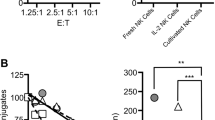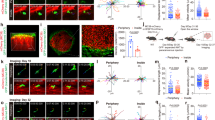Abstract
Cytotoxicity of cytokine-induced killer (CIK) cells depends mainly on their encounters with target cells, but how many CIK cells are required to kill an individual cancer cell is unknown. Here we used time-lapse imaging to quantify the critical effector cell number required to kill an individual target cell. CIK cells killed MHC-I-negative and MHC-I-positive cancer cells, but natural killer (NK) cells destroyed MHC-I-negative cells only. The average threshold number of CIK cells required to kill an individual cancer cell was 6.7 for MHC-I-negative cells and 6.9 for MHC-I-positive cells. That of NK cells was 2.4 for MHC-I-negative cells. Likely due to the higher threshold numbers, killing by CIK cells was delayed in comparison with NK cells: 40% of MHC-negative target cells were killed after 5 h when co-cultured with CIK cells and after 2 h with NK cells. Our data have implications for the rational design of CIK cell-based immunotherapy of cancer patients.






Similar content being viewed by others
Abbreviations
- APC:
-
Allophycocyanin
- Calcein-AM:
-
Calcein acetoxymethyl ester
- CIK:
-
Cytokine-induced killer
- DNAM-1:
-
DNAX accessory molecule-1
- FasL:
-
Fas ligand
- MS:
-
Mesenchymal stem cell
- NKG2A:
-
NK group 2 member A
- NKG2D:
-
NK group 2 member D
- SEM:
-
Standard error of the mean
- TIGIT:
-
T-cell immunoglobulin and ITIM domain
References
Rosenberg SA, Restifo NP (2015) Adoptive cell transfer as personalized immunotherapy for human cancer. Science 348:62–68. doi:10.1126/science.aaa4967
Aranda F, Buque A, Bloy N, Castoldi F, Eggermont A, Cremer I, Fridman WH, Fucikova J, Galon J, Spisek R, Tartour E, Zitvogel L, Kroemer G, Galluzzi L (2015) Trial watch: adoptive cell transfer for oncological indications. Oncoimmunology 4:e1046673. doi:10.1080/2162402X.2015.1046673
Schmeel FC, Schmeel LC, Gast SM, Schmidt-Wolf IG (2014) Adoptive immunotherapy strategies with cytokine-induced killer (CIK) cells in the treatment of hematological malignancies. Int J Mol Sci 15:14632–14648. doi:10.3390/ijms150814632
Lee HK, Kim YG, Kim JS, Park EJ, Kim B, Park KH, Kang JS, Hong JT, Kim Y, Han SB (2016) Cytokine-induced killer cells interact with tumor lysate-pulsed dendritic cells via CCR5 signaling. Cancer Lett 378:142–149. doi:10.1016/j.canlet.2016.05.020
Schmidt-Wolf IG, Lefterova P, Johnston V, Scheffold C, Csipai M, Mehta BA, Tsuruo T, Huhn D, Negrin RS (1996) Sensitivity of multidrug-resistant tumor cell lines to immunologic effector cells. Cell Immunol 169:85–90. doi:10.1006/cimm.1996.0094
Zhang YS, Yuan FJ, Jia GF, Zhang JF, Hu LY, Huang L, Wang J, Dai ZQ (2005) CIK cells from patients with HCC possess strong cytotoxicity to multidrug-resistant cell line Bel-7402/R. World J Gastroenterol 11:3339–3345
Zhao Q, Zhang H, Li Y, Liu J, Hu X, Fan L (2010) Anti-tumor effects of CIK combined with oxaliplatin in human oxaliplatin-resistant gastric cancer cells in vivo and in vitro. J Exp Clin Cancer Res 29:118. doi:10.1186/1756-9966-29-118
Nishimura R, Baker J, Beilhack A, Zeiser R, Olson JA, Sega EI, Karimi M, Negrin RS (2008) In vivo trafficking and survival of cytokine-induced killer cells resulting in minimal GVHD with retention of antitumor activity. Blood 112:2563–2574. doi:10.1182/blood-2007-06-092817
Dai C, Lin F, Geng R, Ge X, Tang W, Chang J, Wu Z, Liu X, Lin Y, Zhang Z, Li J (2016) Implication of combined PD-L1/PD-1 blockade with cytokine-induced killer cells as a synergistic immunotherapy for gastrointestinal cancer. Oncotarget 7:10332–10344. doi:10.18632/oncotarget.7243
Chester C, Fritsch K, Kohrt HE (2015) Natural Killer Cell Immunomodulation: targeting Activating, Inhibitory, and Co-stimulatory Receptor Signaling for Cancer Immunotherapy. Front Immunol 6:601. doi:10.3389/fimmu.2015.00601
Lanier LL (2005) NK cell recognition. Annu Rev Immunol 23:225–274. doi:10.1146/annurev.immunol.23.021704.115526
Long EO (2008) Negative signaling by inhibitory receptors: the NK cell paradigm. Immunol Rev 224:70–84. doi:10.1111/j.1600-065X.2008.00660.x
Raulet DH, Gasser S, Gowen BG, Deng W, Jung H (2013) Regulation of ligands for the NKG2D activating receptor. Annu Rev Immunol 31:413–441. doi:10.1146/annurev-immunol-032712-095951
Mathew SO, Rao KK, Kim JR, Bambard ND, Mathew PA (2009) Functional role of human NK cell receptor 2B4 (CD244) isoforms. Eur J Immunol 39:1632–1641. doi:10.1002/eji.200838733
Zhang Z, Wu N, Lu Y, Davidson D, Colonna M, Veillette A (2015) DNAM-1 controls NK cell activation via an ITT-like motif. J Exp Med 212:2165–2182. doi:10.1084/jem.20150792
Verneris MR, Karimi M, Baker J, Jayaswal A, Negrin RS (2004) Role of NKG2D signaling in the cytotoxicity of activated and expanded CD8 + T cells. Blood 103:3065–3072. doi:10.1182/blood-2003-06-2125
Zhang B, Zhao W, Li H, Chen Y, Tian H, Li L, Zhang L, Gao C, Zheng J (2016) Immunoreceptor TIGIT inhibits the cytotoxicity of human cytokine-induced killer cells by interacting with CD155. Cancer Immunol Immunother 65:305–314. doi:10.1007/s00262-016-1799-4
Pievani A, Borleri G, Pende D, Moretta L, Rambaldi A, Golay J, Introna M (2011) Dual-functional capability of CD3 + CD56 + CIK cells, a T-cell subset that acquires NK function and retains TCR-mediated specific cytotoxicity. Blood 118:3301–3310. doi:10.1182/blood-2011-02-336321
Kim YJ, Lim J, Kang JS, Kim HM, Lee HK, Ryu HS, Kim JY, Hong JT, Kim Y, Han SB (2010) Adoptive immunotherapy of human gastric cancer with ex vivo expanded T cells. Arch Pharm Res 33:1789–1795. doi:10.1007/s12272-010-1111-7
Kim HS, Lee YJ, Lee HK, Kim JS, Park Y, Kang JS, Hwang BY, Hong JT, Kim Y, Han SB (2013) Bisabolangelone inhibits dendritic cell functions by blocking MAPK and NF-kappaB signaling. Food Chem Toxicol 59:26–33. doi:10.1016/j.fct.2013.05.013
Weidmann E, Brieger J, Jahn B, Hoelzer D, Bergmann L, Mitrou PS (1995) Lactate dehydrogenase-release assay: a reliable, nonradioactive technique for analysis of cytotoxic lymphocyte-mediated lytic activity against blasts from acute myelocytic leukemia. Ann Hematol 70:153–158
Kim JY, Kim YJ, Kim JS, Ryu HS, Lee HK, Kang JS, Kim HM, Hong JT, Kim Y, Han SB (2011) Adjuvant effect of a natural TLR4 ligand on dendritic cell-based cancer immunotherapy. Cancer Lett 313:226–234. doi:10.1016/j.canlet.2011.09.009
Schmidt-Wolf IG, Negrin RS, Kiem HP, Blume KG, Weissman IL (1991) Use of a SCID mouse/human lymphoma model to evaluate cytokine-induced killer cells with potent antitumor cell activity. J Exp Med 174:139–149
Linn YC, Lau SK, Liu BH, Ng LH, Yong HX, Hui KM (2009) Characterization of the recognition and functional heterogeneity exhibited by cytokine-induced killer cell subsets against acute myeloid leukaemia target cell. Immunology 126:423–435. doi:10.1111/j.1365-2567.2008.02910.x
Sturmhofel K, Hammerling GJ (1990) Reconstitution of H-2 class I expression by gene transfection decreases susceptibility to natural killer cells of an EL4 class I loss variant. Eur J Immunol 20:171–177. doi:10.1002/eji.1830200125
Maziarz RT, Mentzer SJ, Burakoff SJ, Faller DV (1990) Distinct effects of interferon-gamma and MHC class I surface antigen levels on resistance of the K562 tumor cell line to natural killer-mediated lysis. Cell Immunol 130:329–338
Maio M, Altomonte M, Tatake R, Zeff RA, Ferrone S (1991) Reduction in susceptibility to natural killer cell-mediated lysis of human FO-1 melanoma cells after induction of HLA class I antigen expression by transfection with B2 m gene. J Clin Invest 88:282–289. doi:10.1172/JCI115289
Ding X, Cao H, Chen X, Jin H, Liu Z, Wang G, Cai L, Li D, Niu C, Tian H, Yang L, Zhao Y, Li W, Cui J (2015) Cellular immunotherapy as maintenance therapy prolongs the survival of the patients with small cell lung cancer. J Transl Med 13:158. doi:10.1186/s12967-015-0514-0
Niu C, Jin H, Li M, Xu J, Xu D, Hu J, He H, Li W, Cui J (2015) In vitro analysis of the proliferative capacity and cytotoxic effects of ex vivo induced natural killer cells, cytokine-induced killer cells, and gamma-delta T cells. BMC Immunol 16:61. doi:10.1186/s12865-015-0124-x
Forslund E, Sohlberg E, Enqvist M, Olofsson PE, Malmberg KJ, Onfelt B (2015) Microchip-Based Single-Cell Imaging Reveals That CD56dimCD57-KIR-NKG2A + NK Cells Have More Dynamic Migration Associated with Increased Target Cell Conjugation and Probability of Killing Compared to CD56dimCD57-KIR-NKG2A- NK Cells. J Immunol 195:3374–3381. doi:10.4049/jimmunol.1500171
Olofsson PE, Forslund E, Vanherberghen B, Chechet K, Mickelin O, Ahlin AR, Everhorn T, Onfelt B (2014) Distinct Migration and Contact Dynamics of Resting and IL-2-Activated Human Natural Killer Cells. Front Immunol 5:80. doi:10.3389/fimmu.2014.00080
Vanherberghen B, Olofsson PE, Forslund E, Sternberg-Simon M, Khorshidi MA, Pacouret S, Guldevall K, Enqvist M, Malmberg KJ, Mehr R, Onfelt B (2013) Classification of human natural killer cells based on migration behavior and cytotoxic response. Blood 121:1326–1334. doi:10.1182/blood-2012-06-439851
Zhao X, Zhang Z, Li H, Huang J, Yang S, Xie T, Huang L, Yue D, Xu L, Wang L, Zhang W, Zhang Y (2015) Cytokine induced killer cell-based immunotherapies in patients with different stages of renal cell carcinoma. Cancer Lett 362:192–198. doi:10.1016/j.canlet.2015.03.043
Wang S, Wang Z (2015) Efficacy and safety of dendritic cells co-cultured with cytokine-induced killer cells immunotherapy for non-small-cell lung cancer. Int Immunopharmacol 28:22–28. doi:10.1016/j.intimp.2015.05.021
Chieregato K, Albiero E, Castegnaro S, Bernardi M, d’Amore ES, Zanon C, Madeo D, Rodeghiero F, Astori G (2012) A study on mutual interaction between cytokine induced killer cells and umbilical cord-derived mesenchymal cells: implication for their in vivo use. Blood Cells Mol Dis 49:159–165. doi:10.1016/j.bcmd.2012.05.009
Li Y, Qu YH, Wu YF, Liu L, Lin XH, Huang K, Wei J (2015) Bone marrow mesenchymal stem cells suppressing activation of allogeneic cytokine-induced killer/natural killer cells either by direct or indirect interaction. Cell Biol Int 39:435–445. doi:10.1002/cbin.10404
Li Y, Qu YH, Wu YF, Wang XP, Wei J, Huang WG, Zhou DH, Fang J, Huang K, Huang SL (2011) Bone marrow mesenchymal stem cells reduce the antitumor activity of cytokine-induced killer/natural killer cells in K562 NOD/SCID mice. Ann Hematol 90:873–885. doi:10.1007/s00277-011-1156-9
Acknowledgements
This study was supported by a grant funded by the Korean Government (NRF-2008-0062275).
Author information
Authors and Affiliations
Corresponding author
Ethics declarations
Conflict of interest
The authors declare that they have no conflict of interest.
Additional information
Ji Sung Kim and Yong Guk Kim are co-first authors and have contributed equally.
Electronic supplementary material
Below is the link to the electronic supplementary material.
Supplementary material 2 (MP4 1113 kb)
Supplementary material 3 (MP4 1016 kb)
Supplementary material 4 (MP4 1287 kb)
Supplementary material 5 (MP4 1551 kb)
Supplementary material 6 (MP4 375 kb)
Rights and permissions
About this article
Cite this article
Kim, J.S., Kim, Y.G., Lee, H.K. et al. Cytokine-induced killer cells hunt individual cancer cells in droves in a mouse model. Cancer Immunol Immunother 66, 193–202 (2017). https://doi.org/10.1007/s00262-016-1934-2
Received:
Accepted:
Published:
Issue Date:
DOI: https://doi.org/10.1007/s00262-016-1934-2




